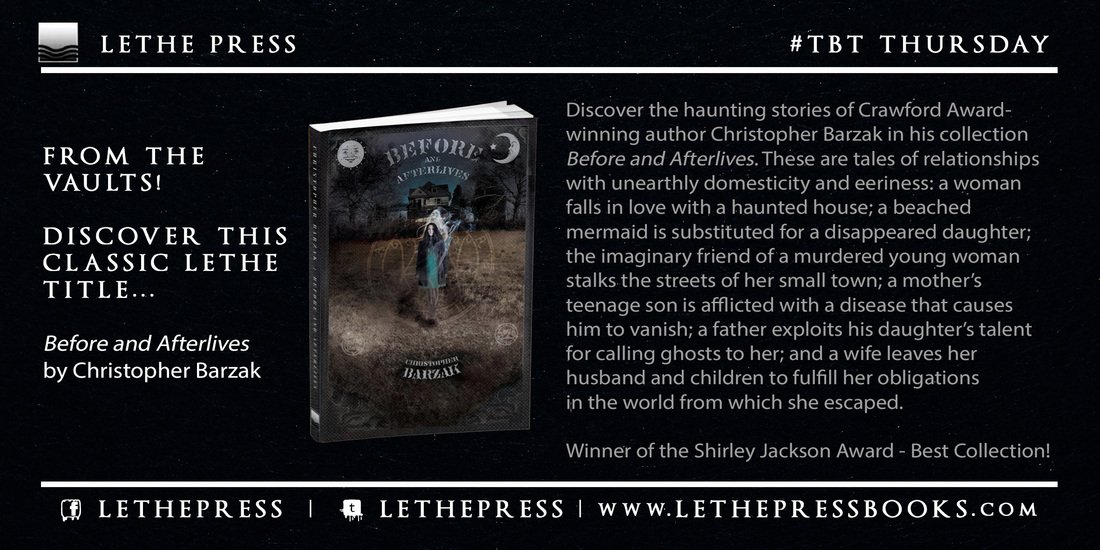|
Every Thursday, Lethe takes a look through its vaults for its proudest releases. This week it's Before and Afterlives, the Shirley Jackson Award-winning collection from Christopher Barzak (the author of the novel One For Sorrow, adapted for film as Jamie Marks Is Dead - The Love We Share Without Knowing and Wonders of the Invisible World.) Even better, Before and Afterlives is just $5 for the paperback all week at the Lethe website. Read an excerpt from the story 'The Boy Was Was Born Wrapped In Barbed Wire': There was once a boy who was born wrapped in barbed wire. The defect was noticed immediately after his birth, when the doctor had to snip the boy’s umbilical cord with wire cutters. But elsewhere, too, the wire curled out of the boy’s flesh, circling his arms and legs, his tiny torso. They didn’t cause him pain, these metal spikes that grew out of the round hills of his body, although due to the dangerous nature of his birth, his mother had lost a great amount of blood during labor. After delivery, the nurse laid the boy in his mother’s arms, careful to show her the safe places to hold him. And before her last breath left her, she managed to tell her son these words: “Bumblebees fly anyway, my love.” They followed him, those words, for the rest of his life, skimming the rim of his ear, buzzing loud as the bees farmed by his father the beekeeper. He did not remember his mother saying those words, but he often imagined the scene as his father described it. “Your mother loved you very much,” he told the boy, blinking, pursing his lips. The beekeeper wanted to pat his son’s head, but was unable to touch him just there—on his crown—where a cowlick of barbs jutted out of the boy’s brown curls. The beekeeper and his son lived in a cabin in the middle of the woods. They only came out to go into town for supplies and groceries. The beekeeper took the boy with him whenever he trekked through the woods to his hives. He showed the boy how to collect honey, how to not disturb the bees, how to avoid an unnecessary stinging. Sometimes the beekeeper wore a baggy white suit with a helmet and visor, which the bees clung to, crawling over the surface of his body. The boy envied the bees that landscape. He imagined himself a bee in those moments. As a bee, his sting would never slip through his father’s suit to strike the soft flesh hidden beneath it. His barbs, though, would find their way through nearly any barrier. One day the beekeeper gave the boy a small honeycomb and told him to eat it. The comb dripped a sticky gold, and the boy wrinkled his nose. “It looks like wax,” he told his father. But the beekeeper only said, “Eat,” so the boy did. The honeycomb filled his mouth with a sweetness that tasted of sunlight on water. Never before had something so beautiful sat on the tip of his tongue. Swallowing, he closed his eyes and thought of his mother. The way she held him in her arms before dying, the way she spoke before going away forever. The memory of his mother tasted like honey too, and he asked the beekeeper, “What did she mean? Bumblebees fly anyway?” “Bumblebees shouldn’t be able to fly,” said the beekeeper, closing the lid on a hive. Honeybees crawled on the inside of the lid like a living carpet. “Their bodies are so large and their wings so small, they shouldn’t be able to lift themselves into the air, but somehow they do. They fly.” When the boy turned five, the beekeeper sent him to school with the town’s other children. At first the boy was excited, standing on the shoulder of the highway where the trail that led back through the woods to the beekeeper’s cabin ended. But soon the bus came and, as he stepped inside, he realized none of the other kids had been born wrapped in barbed wire. They were regular flesh children with soft hair any adult could run their fingers through. They looked at him, eyes wide, and said nothing. No one offered him a seat, so the boy sat behind the bus driver. They all knew of the barbed wire boy, of course, from tales that had circulated since the day of his birth. But only a few had actually seen him. The one story the children lived on was told by a girl who had seen him in the fruit section of the grocery store late one night, shopping with his father. He had reached for a bunch of grapes, she said, but the grapes got tangled in the wire around his hand. His father bent down to remove them, carefully pulling the vines away, but several grapes remained stuck on his barbs, their juice sliding down the metal. “The manager made them buy that bunch,” the girl said with an air of righteousness. After all, those grapes were ruined. On his first day of class, no one talked to him except the teacher, Ms. Morrison, who told him where he could sit. She pointed to a desk in the back of the room, far away from the rows of desks that held the other children. When he looked up at her, she could already see the question forming on the cage of his face and said, “For their safety, dear. And for yours.” Ms. Morrison taught the boy how to read, how to write, and how to add numbers. He already knew how to subtract. His father had taught him that. So he was ahead of the class, or behind them, depending on your view of subtraction. This is how the barbed wire boy learned to subtract: “How old am I?” he once asked the beekeeper. “It’s been four years since your mother died,” the beekeeper replied. “Four,” said the barbed wire boy. “How much is four, Father?” “Four is one less than five,” said the beekeeper. “Three is one less than four. And two is what your mother and I once were together.” It was only once Ms. Morrison took an apple and orange and put them together that the boy realized things could grow in number. The barbed wire boy kept to himself, but his solitude was not of his own choosing. The town parents had warned their children. “You could get hurt playing with that boy,” they said. “You could get tangled up in his barbed wire and then what would you do?” The barbed wire boy understood their reluctance to engage him, but it would be lying to say he did not long for a friend. For someone to at least confide in. Day after day he sat on the teeter-totter during recess, waiting for someone to climb onto the side opposite, someone whose weight would lift him high into the air. All Lethe Press books, including Before and Afterlives, are available through the major online retailers and booksellers. You can also support the press and authors by buying directly from our website.
0 Comments
Your comment will be posted after it is approved.
Leave a Reply. |
Lethe PressWhat's new with Lethe Press... Archives
June 2020
Categories
All
|
Proudly powered by Weebly


 RSS Feed
RSS Feed